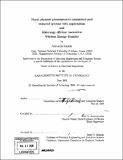| dc.contributor.advisor | John D. Joannopoulos. | en_US |
| dc.contributor.author | Karalis, Aristeidis, 1978- | en_US |
| dc.contributor.other | Massachusetts Institute of Technology. Dept. of Electrical Engineering and Computer Science. | en_US |
| dc.date.accessioned | 2009-01-30T16:47:29Z | |
| dc.date.available | 2009-01-30T16:47:29Z | |
| dc.date.copyright | 2008 | en_US |
| dc.date.issued | 2008 | en_US |
| dc.identifier.uri | http://hdl.handle.net/1721.1/44444 | |
| dc.description | Thesis (Sc. D.)--Massachusetts Institute of Technology, Dept. of Electrical Engineering and Computer Science, 2008. | en_US |
| dc.description | Includes bibliographical references (p. 195-204). | en_US |
| dc.description.abstract | A set of novel mechanisms for the manipulation of light in the nanoscale is provided. In the class of all-dielectric material systems, techniques for the suppression of radiative loss from incomplete-photonic-bandgap structures are developed: the cancellation of radiation channeled into discrete modes of the substrate, for resonant small-modal-volume cavities with patterned substrates, and the broadband mode-matching across the coupling interface, for large-bandwidth butt-coupled devices. Moreover, a hybrid plasmonic-dielectric material platform is introduced, able to localize light counter intuitively in low-index regions, by employing the unique subwavelength and cutoff properties of polaritonic waves, and to support dispersionless (to unusually-high orders) broadband-slow or stopped subwavelength light, by utilizing a simple planar multilayered dielectric structure. This platform can achieve a significant reduction in all (temporal, spatial and energy) light-scales and could enable compact and efficient optical buffers and active devices. A method for mid-range efficient and insensitive wireless energy-transfer is proposed. A condition of 'strong coupling' of resonances is identified as necessary and sufficient for efficient energy-exchange, and is shown to be satisfied at mid-range distances by carefully-designed high-Q subwavelength resonances of realistic systems both theoretically and experimentally, in the latter case by powering a 60W light-bulb wirelessly across a 2m-distance using two 60cm-diameter resonant objects and with 45% efficiency. A technique for further efficiency enhancement and radiation suppression is suggested, based on employing destructive interference between the coupled-objects' radiated far-fields. The scheme is also found fairly insensitive to the near-presence of extraneous objects, especially when utilizing the special class of magneto-quasi-static resonances. | en_US |
| dc.description.abstract | (cont.) Applications of the proposed wireless-powering method can be found in both the macro- and micro-worlds, and range among industrial, technological, medical, consumer and more. | en_US |
| dc.description.statementofresponsibility | by Aristeidis Karalis. | en_US |
| dc.format.extent | 204 p. | en_US |
| dc.language.iso | eng | en_US |
| dc.publisher | Massachusetts Institute of Technology | en_US |
| dc.rights | M.I.T. theses are protected by
copyright. They may be viewed from this source for any purpose, but
reproduction or distribution in any format is prohibited without written
permission. See provided URL for inquiries about permission. | en_US |
| dc.rights.uri | http://dspace.mit.edu/handle/1721.1/7582 | en_US |
| dc.subject | Electrical Engineering and Computer Science. | en_US |
| dc.title | Novel photonic phenomena in nanostructured material systems with applications and mid-range efficient insensitive wireless energy-transfer | en_US |
| dc.title.alternative | Mid-range efficient insensitive wireless energy-transfer | en_US |
| dc.type | Thesis | en_US |
| dc.description.degree | Sc.D. | en_US |
| dc.contributor.department | Massachusetts Institute of Technology. Department of Electrical Engineering and Computer Science | |
| dc.identifier.oclc | 294909582 | en_US |
